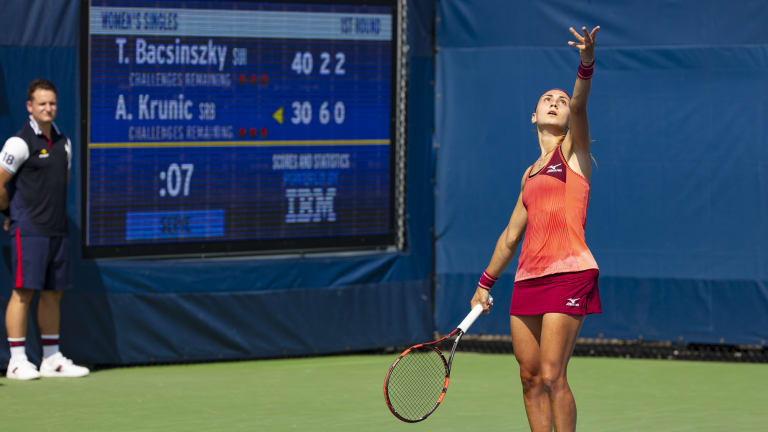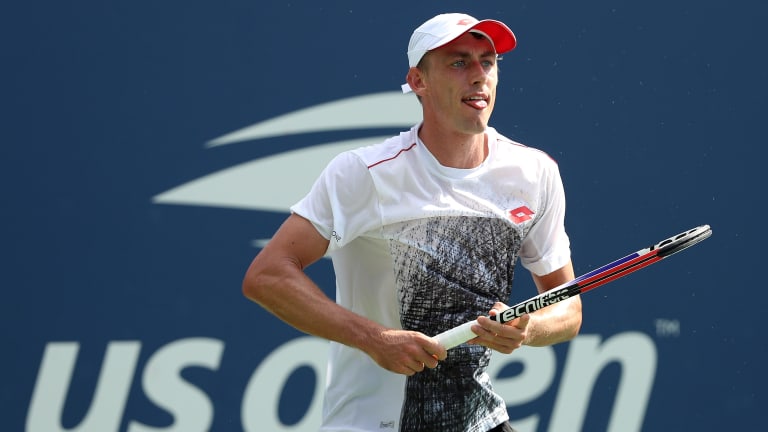WATCH—Court Report from Day 1 at the US Open:
An early look at the pros and cons of tennis' new serve clock
By Steve Tignor Aug 29, 2018Madrid, Spain
China's Wang Xinyu saves 10 match points in first-round Madrid win over Viktoriya Tomova
By TENNIS.com Apr 24, 2024Pop Culture
Review: Plenty to be excited about in TopSpin 2K25, which successfully recreates the joy (and frustration) of tennis
By Stephanie Livaudais and Spencer Thordarson Apr 24, 2024Madrid, Spain
Fabian Marozsan saves 11 set points, wins pair of Madrid tie-breaks to defeat Aslan Karatsev
By TENNIS.com Apr 24, 2024Pop Culture
Coco Gauff dishes on 'embracing adulthood' in TIME magazine's May cover story
By Baseline Staff Apr 24, 2024Pick of the Day
Roberto Carballes Baena vs. Dominik Koepfer, Madrid
By Zachary Cohen Apr 24, 2024Madrid, Spain
Caroline Wozniacki stumbles in clay comeback, exits Madrid in nostalgic Errani match
By David Kane Apr 24, 2024Madrid, Spain
Rafael Nadal says he is not 100% fit ahead of Madrid debut and unsure about playing Roland Garros
By Associated Press Apr 24, 2024Line Calls
ATP Mutua Madrid Open Betting Preview
By Baseline Staff Apr 24, 2024Madrid, Spain
Despite jet lag, Sloane Stephens keeps winning in Madrid with big goals for clay swing
By David Kane Apr 24, 2024An early look at the pros and cons of tennis' new serve clock
Published Aug 29, 2018
Advertising
NEW YORK—For some in tennis, the serve clock was long awaited. For others, it was long dreaded. Not surprisingly, its introduction during the North American hard-court season this summer has drawn mixed reviews.
“I just don’t like it,” Novak Djokovic complained.
“I think it’s quite cool,” Elina Svitolina enthused.
“I hate it,” Serena Williams decided.
“Overall, it’s fine,” Petra Kvitova concluded.
But it may have been Sloane Stephens who made the most prescient serve-clock comment of all when she was asked for her opinion of it at the tour stop in Cincinnati.
“I think that the shot clock is another human, like, to start it, stop it, whatever,” Stephens said. “It’s all human, whatever.”
Somewhere underneath the quintessentially Sloanian “whatever”s, Stephens may have gotten to the heart of the serve-clock matter. Yes, it’s a technological addition to the game, and it ticks away implacably at the back of the court. But when to start it, when to pause it, when to stop it: All of that is controlled by a human—i.e., the chair umpire.
This was true before the advent of the clock, of course. The chair umpire has always kept track of the time that players take between points, and warned them—and occasionally penalized them—when they went over the 25-second limit. It’s just that now, finally, the players can see the numbers in black and white.
And what is the human reaction to seeing how much time you’ve been allotted to get something done? Procrastinators everywhere know the answer: To take as much of it as possible. We’ve all heard the phrase, “Why do today what you can do tomorrow?” The tennis version may become, “Why do in 10 seconds what you can do in 25?” According to Svitolina, she’s learning to use that extra time wisely.
“It’s actually quite cool because I’m always so quick, so now I can take my time more,” Svitolina said. “Sometimes I don’t even make a decision where I’m going to serve next, so now I can see that I still have 15 seconds, and I can take my time to think about what I’m going to do.”
Svitolina’s reaction is the natural one, and it may be a common one among players. The serve clock has only been in operation for five weeks, so any findings about its effects are obviously preliminary. But according to Jeff Sackmann at the Tennis Abstract ****website, players at the tournaments that have used the shot clock—Cincinnati, Canada, D.C., San Jose—are taking slightly longer, by roughly a second, to play points. As for who benefits and who is hurt by the change, on the men’s side the clock has yet to make a difference: The ATP’s two poster boys for slow play, Rafael Nadal and Novak Djokovic, won the first two Masters 1000 events with a serve clock, in Toronto and Cincinnati.
Advertising

An early look at the pros and cons of tennis' new serve clock
Anyone who was hoping for brisker matches at this year’s US Open may also be disappointed. On Monday, attrition was still the name of the game. Just two first-round contests were scheduled in Arthur Ashe Stadium—Stan Wawrinka vs. Grigor Dimitrov and Venus Williams vs. Svetlana Kuznetsova—yet their six sets took up five and a half hours. Andy Murray took three hours and 17 minutes to beat James Duckworth in four sets, while marathon man Kevin Anderson was at it again, using up four hours and 14 minutes to fend off Ryan Harrison.
Granted, this week in New York may not make for an ideal sample. It has been unbearably hot and humid at the Open so far, and few would begrudge the players taking an extra second or two between points. But after watching a dozen matches here so far, another human variable of the shot clock becomes obvious: The role of the chair umpire in starting the clock in the first place.
This happens when the umpire announces the score, but this seemingly simple decision requires a lot of consideration. How hot is it? How long was the previous point? How long will the post-point applause last? If it’s a tiebreaker, have the ball kids thrown the balls to the other side of the court?
Over the course of the Open’s first day, those decisions varied. During Kaia Kanepi’s upset win over Simona Halep, the umpire waited a significant amount of time for the applause to die down before announcing the score. On the same court in the evening, though, Marija Cicak kept Juan Martin del Potro and Donald Young to a brisk pace. With Cicak calling the score almost immediately after each point, the two players had little time to dawdle, and the match seemed to move at an ideal speed. But could Cicak have kept Delpo and Young to that pace if it had been the middle of a sweltering day, and their points had been longer?
In 2017, the US Open tried out the serve clock in qualifying. Watching that experiment, it seemed to me that whether or not the time between points was actually shortened, simply having a clock on court improved the fan experience. Spectators no longer had to wonder if a player was taking too long, and there was a sense that the match was moving forward at a consistent, regulated clip, with no time wasted. That increased sense of time control has been evident so far this year at Flushing Meadows as well. Instituting a clock before the coin toss has seemed like an especially useful innovation.
Still, matches have continued to go long, and that ultimately is what tennis wants to change. Is there a tweak that could help? The Grand Slams theoretically used to allow 20, rather than 25, seconds between points; that limit could be reinstituted. Chair umpires could be encouraged to take less time before calling the score. Or, if matches continue to lengthen, the timer could be hidden away again.
Now that the clock is on the court, though, and the cat is out of the bag, it would only be human for the players to want to know how much time they have to do their jobs, and to keep taking as much of it as they can.
Advertising

An early look at the pros and cons of tennis' new serve clock
© 2018 Getty Images
From Kamakshi Tandon: Millman slams "teething problems" with serve clock
NEW YORK—Australian John Millman criticized different rules and use of the serve clock between different courts at the US Open, saying players on the show courts are getting more time between points.
Players are allowed to sit down longer on the show courts to allow for television commercials, and length of breaks are now more strictly enforced because of the shot clock.
"We got 60 seconds from when the umpire calls the score. They get a minute and a half in there," Millman said following his first-round win on Court 6.
The tournament is the first Grand Slam to use a shot clock, and though all players get 25 seconds from when the umpire calls the score, Millman noted that there is more spectator reaction on the stadium courts. This can create delays in the calling of the score and give players more time between points.
There has been unusually hot weather during the start of the US Open, so any extra rest becomes more significant.
"Especially in these conditions," he said. "If there’s a big round of applause on centre court there, then they get, what, an extra 10, 15 seconds. It’s got to be the same for everyone."
While the shot clock was also used during four weeks of warm-up events, Millman argued that it requires further improvement, saying, "They’ve got a fair few teething issues and it would be nice if they don’t have those teething issues at a US Open."
The No. 55 also said the tournament should have attempted to "gauge the temperature" among players before introducing a 10-minute heat break between the third and fourth sets for the men, saying they had "made up the rules."
"Probably not the biggest fan of the 10-minute break. I don’t know if it does you much good," he said.
Millman defeated wild card Jenson Brooksby in three sets to reach the second round.
Advertising

An early look at the pros and cons of tennis' new serve clock
Wake up every morning with Tennis Channel Live at the US Open starting at 8 a.m. ET. For three hours leading up to the start of play, Tennis Channel’s team will break down upcoming matches, review tournament storylines, breaking news and player developments.
Tennis Channel’s encore, all-night match coverage will begin every evening at 11 p.m. ET, with the exception of earlier starts on Saturday and Sunday of championship weekend.
Watch the best matches from the first three Grand Slams on Tennis Channel PLUS. From Federer’s historic win at the Australian Open to Halep’s breakthrough at Roland Garros. It all starts Monday, August 27th.
Follow the Race to ATP Finals this fall on Tennis Channel PLUS. Live coverage from the biggest stops including Beijing, Tokyo, Shanghai & Paris.